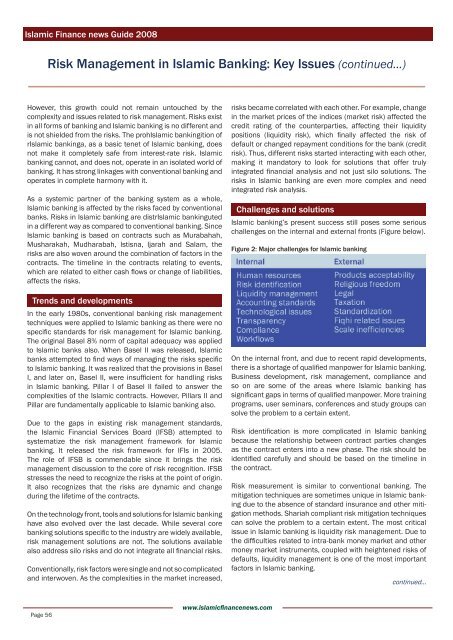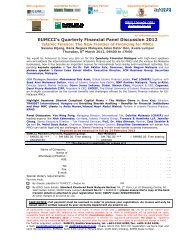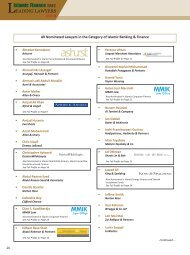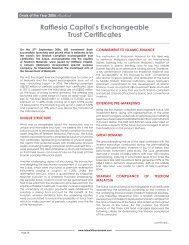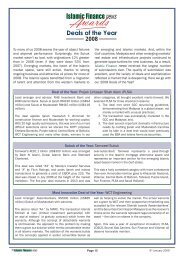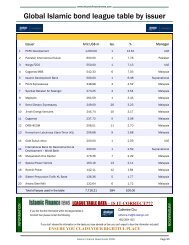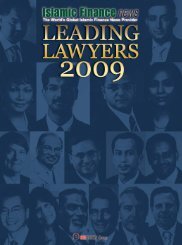Create successful ePaper yourself
Turn your PDF publications into a flip-book with our unique Google optimized e-Paper software.
<strong>Islamic</strong> <strong>Finance</strong> news Guide 2008<br />
Page 56<br />
Risk Management in <strong>Islamic</strong> Banking: Key Issues (<strong>continued</strong>...)<br />
However, this growth could not remain untouched by the<br />
complexity and issues related to risk management. Risks exist<br />
in all forms of banking and <strong>Islamic</strong> banking is no different and<br />
is not shielded from the risks. The proh<strong>Islamic</strong> bankingition of<br />
r<strong>Islamic</strong> bankinga, as a basic tenet of <strong>Islamic</strong> banking, does<br />
not make it completely safe from interest-rate risk. <strong>Islamic</strong><br />
banking cannot, and does not, operate in an isolated world of<br />
banking. It has strong linkages with conventional banking and<br />
operates in complete harmony with it.<br />
As a systemic partner of the banking system as a whole,<br />
<strong>Islamic</strong> banking is affected by the risks faced by conventional<br />
banks. Risks in <strong>Islamic</strong> banking are distr<strong>Islamic</strong> bankinguted<br />
in a different way as compared to conventional banking. Since<br />
<strong>Islamic</strong> banking is based on contracts such as Murabahah,<br />
Musharakah, Mudharabah, Istisna, Ijarah and Salam, the<br />
risks are also woven around the combination of factors in the<br />
contracts. The timeline in the contracts relating to events,<br />
which are related to either cash fl ows or change of liabilities,<br />
affects the risks.<br />
Trends and developments<br />
In the early 1980s, conventional banking risk management<br />
techniques were applied to <strong>Islamic</strong> banking as there were no<br />
specifi c standards for risk management for <strong>Islamic</strong> banking.<br />
The original Basel 8% norm of capital adequacy was applied<br />
to <strong>Islamic</strong> banks also. When Basel II was released, <strong>Islamic</strong><br />
banks attempted to fi nd ways of managing the risks specifi c<br />
to <strong>Islamic</strong> banking. It was realized that the provisions in Basel<br />
I, and later on, Basel II, were insuffi cient for handling risks<br />
in <strong>Islamic</strong> banking. Pillar I of Basel II failed to answer the<br />
complexities of the <strong>Islamic</strong> contracts. However, Pillars II and<br />
Pillar are fundamentally applicable to <strong>Islamic</strong> banking also.<br />
Due to the gaps in existing risk management standards,<br />
the <strong>Islamic</strong> Financial Services Board (IFSB) attempted to<br />
systematize the risk management framework for <strong>Islamic</strong><br />
banking. It released the risk framework for IFIs in 2005.<br />
The role of IFSB is commendable since it brings the risk<br />
management discussion to the core of risk recognition. IFSB<br />
stresses the need to recognize the risks at the point of origin.<br />
It also recognizes that the risks are dynamic and change<br />
during the lifetime of the contracts.<br />
On the technology front, tools and solutions for <strong>Islamic</strong> banking<br />
have also evolved over the last decade. While several core<br />
banking solutions specifi c to the industry are widely available,<br />
risk management solutions are not. The solutions available<br />
also address silo risks and do not integrate all fi nancial risks.<br />
Conventionally, risk factors were single and not so complicated<br />
and interwoven. As the complexities in the market increased,<br />
www.islamicfi nancenews.com<br />
risks became correlated with each other. For example, change<br />
in the market prices of the indices (market risk) affected the<br />
credit rating of the counterparties, affecting their liquidity<br />
positions (liquidity risk), which fi nally affected the risk of<br />
default or changed repayment conditions for the bank (credit<br />
risk). Thus, different risks started interacting with each other,<br />
making it mandatory to look for solutions that offer truly<br />
integrated fi nancial analysis and not just silo solutions. The<br />
risks in <strong>Islamic</strong> banking are even more complex and need<br />
integrated risk analysis.<br />
Challenges and solutions<br />
<strong>Islamic</strong> banking’s present success still poses some serious<br />
challenges on the internal and external fronts (Figure below).<br />
Figure 2: Major challenges for <strong>Islamic</strong> banking<br />
On the internal front, and due to recent rapid developments,<br />
there is a shortage of qualifi ed manpower for <strong>Islamic</strong> banking.<br />
Business development, risk management, compliance and<br />
so on are some of the areas where <strong>Islamic</strong> banking has<br />
signifi cant gaps in terms of qualifi ed manpower. More training<br />
programs, user seminars, conferences and study groups can<br />
solve the problem to a certain extent.<br />
Risk identifi cation is more complicated in <strong>Islamic</strong> banking<br />
because the relationship between contract parties changes<br />
as the contract enters into a new phase. The risk should be<br />
identifi ed carefully and should be based on the timeline in<br />
the contract.<br />
Risk measurement is similar to conventional banking. The<br />
mitigation techniques are sometimes unique in <strong>Islamic</strong> banking<br />
due to the absence of standard insurance and other mitigation<br />
methods. Shariah compliant risk mitigation techniques<br />
can solve the problem to a certain extent. The most critical<br />
issue in <strong>Islamic</strong> banking is liquidity risk management. Due to<br />
the diffi culties related to intra-bank money market and other<br />
money market instruments, coupled with heightened risks of<br />
defaults, liquidity management is one of the most important<br />
factors in <strong>Islamic</strong> banking.<br />
<strong>continued</strong>...


